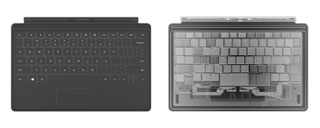Microsoft's Steven Sinofsky and Panos Panay show off the Surface tablet to journalists at an event in Redmond, Wash. on October 15, 2012
During Monday’s press event, I spent enough time fiddling with the Touch Cover and kickstand to be impressed by them. But my biggest question about Surface in general involved another aspect of the cover: I wanted to know how its almost-flat, one-piece keyboard felt.
When I attended the Surface announcement in Los Angeles last June, I took the praise Panay lavished on the Touch Cover seriously enough that I wondered if it might render conventional mechanical keyboards irrelevant–even though Microsoft will offer a mechanical model, the $129 Type Cover, as an option. (It’s thicker than the Touch Cover but strikingly thin by any other standard.)

Microsoft
This time, I got brief hands-on time with a Surface with Touch Cover in one of Microsoft’s labs. I was standing up and it was on a pedestal, so it was hardly a real-world scenario. But it was enough to leave me thinking that the Touch Cover is less of a mechanical-keyboard killer than a pleasing upgrade from an on-screen keyboard.
The keys don’t have travel in the traditional sense, but they’re gentler on the fingertips than thudding your hands against glass. They feel spacious, and there’s no need to switch into special modes to get at numbers or punctuation. I started out making lots of typos and was making fewer of them a few minutes later. And the entirety of the screen was devoted to documents, rather than a sliver above the on-screen keyboard.
Overall, for a keyboard that barely increases the tablet’s thickness and weight, and which can be folded back like a magazine cover, it was remarkably good. But I understand why Microsoft will offer the Type Cover as well.
Even Sinofsky thinks that plasticky little keys still have their place: He told the assembled journalists that he uses the Touch Cover most of the time, but sometimes swaps in the Type Cover for keyboard-intensive work.
After letting us try out the Touch Cover, Microsoft whisked us off of its campus and drove us to a Microsoft Store — one particular Microsoft Store, known as Store Zero. It’s not open to the public: Instead, it’s a concept store where the company tries out ideas before putting them before real people. It’s full-sized and full of real stuff (as well, in some cases, as foam models posing as computers.) We were there to learn about the role the Microsoft Stores will play in the Surface rollout.
The tablet is so new that it will benefit from the sort of explanation that a well-trained Microsoft Store employee might provide. But the still-dinky retail chain is all out of proportion with the grandeur of Surface’s ambitions. There are currently 27 locations, all in the U.S., with another four scheduled to open by the end of the month. (Apple, by contrast, operates around 400 Apple Stores around the world, with more than 50 Apple Stores in California alone.) Microsoft will supplement its permanent outposts with another 34 pop-up “holiday stores” in the U.S. and Canada, which will be open for Surface’s debut, then go away.
Store Zero has already been bedecked as all Microsoft Stores will be come October 26, when Surface and Windows 8 go on sale. To a degree I wasn’t anticipating, it had been converted into a Surface Store. The entire middle of the place, from front to back, was devoted to Surfaces and Surface signage; other Windows 8 computers from other manufacturers were relegated to the sides.
Consumers who buy a Surface at a Microsoft store will get personalized “white glove” introductions to their new Surface Tablet, including an unboxing by a store employee, help setting up a Microsoft Account if necessary and a walkthrough of the Windows Store app marketplace.
Those store staffers will also be responsible for telling shoppers how Surface relates to Windows 8 tablets and various forms of laptop/tablet hybrids. They’ll need to explain what software Surface’s Windows RT operating system can run (new programs designed for the Windows 8-style interface) and can’t run (everything else ever written for Windows, except for Office 2013, which comes bundled with it).
Plenty of pundits–me included–are worrying that millions of normal folk who don’t spend much time reading tech blogs will be confused by Windows RT and may buy Surface tablets under faulty assumptions. At Monday’s event, Sinofsky pretty much brushed aside the concern. “I don’t think a lot of people go to an Apple Store and stare at an iPad and ask if Mac Quicken runs on it,” he said.
Starting a week from Friday, we’ll begin to get a sense of whether pundits like me were fretting unnecessarily, or if Sinofsky was too blasé. In fact, the response of consumers in general–including ones who understand exactly what Surface is and isn’t–is going to be fascinating.
It’s still far from a given whether Windows RT will have what it takes to be an even modestly successful alternative to the iPad juggernaut, but the Surface hardware looks like it’s the thoroughly polished product Microsoft worked so very hard to create. If people don’t want Windows RT on a device this nice, it’s hard to imagine that they’ll want it on anything.


